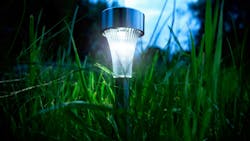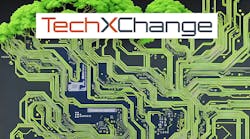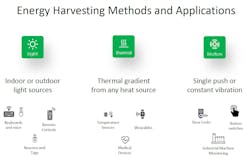The New Era of Energy Harvesting in the IoT
What you’ll learn:
- The benefits of energy-harvesting technology for sustainability.
- Details behind different types of energy harvesting.
- The industries that are leveraging energy-harvesting technology today and what’s ahead.
While many people might think of energy harvesting in terms of capturing the sun’s energy with solar panels on homes and businesses, it’s also a great option for many of the battery-powered devices that will make up the Internet of Things (IoT). In this case, energy harvesting is all about capturing energy from the ambient environment and converting it to usable power. This means free energy for all sorts of devices—and who doesn’t like free stuff?
Benefits of Energy Harvesting
Energy harvesting is a viable option for reducing the IoT’s dependence on batteries. Today, Americans throw away more than three billion batteries each year. When not disposed of properly, batteries can leach toxic chemicals into the soil and pollute drinking water. Batteries can also take over 100 years to decompose, disrupting natural ecosystems for years to come.
Energy-harvesting technology can provide IoT devices with enough power to extend battery life, reducing the number of batteries in a device or eliminating the need for battery replacement for the lifetime of a device. In some cases, energy harvesting enables devices to operate completely battery-free. This can dramatically reduce the number of batteries used across large deployments.
Along with the environmental benefits of reducing battery waste, energy harvesting also significantly lowers operational costs for IoT applications. Battery replacement for an IoT device often costs more in labor and time than the cost of the device itself, especially if the location is hard to reach.
For consumers, who hasn’t had to scramble to find replacement batteries for a remote control that just stopped working? Now imagine that same scenario with thousands of devices deployed in a manufacturing plant or hospital.
Energy-Harvesting Sources
Energy can be harvested from a variety of sources. However, the best harvesting method will depend on what’s available in the operating environment (see figure).
Applications have specific requirements based on their operating environment. Many devices leverage a combination of energy harvesting, power management, and flexible storage to operate and power a device. A few different scenarios for storing power include using a supercapacitor for battery-free operation, employing a standard battery for extended battery life, and using a rechargeable battery so that the battery can operate for the lifetime of the device.
Photovoltaic (PV) harvesting takes advantage of ambient light, be it sunlight, indoor light, or even non-visible light such as infrared. Historically, silicon-based solutions have been used in both outdoor PV cells and small desktop calculators. Now, PV cells based on newer organic polymer and dye-sensitized materials allow for highly customizable PV cells that can be built onto a flexible substrate and shaped into the form factor of the device. These new materials expand the possibilities for integration of PV harvesting into a much wider variety of devices.
Mechanical or kinetic motion represents energy that can be harvested, whether it comes from an actuating motion like the pressing of a button, or the vibration created by a motor in a piece of machinery. Today the mechanical motion of a light switch can be used in smart-lighting controls to send a wireless signal to a distant light fixture, and resonant harvesters affixed to machinery can power intelligent sensors to monitor usage and detect operational anomalies. It’s possible to imagine a future where mechanical harvesting could be leveraged to power applications such as smart clothing.
Finally, it’s also possible to use thermal-harvesting techniques to capture energy from heat sources like compressors and steam pipes or even the human body. Thermal harvesters are based on phenomena discovered almost 200 years ago, where a thermal gradient across certain materials creates current flows that can be captured to power machine monitors and wearable body sensors.
Energy Harvesting in Action
Energy harvesting continues to gain traction across a variety of consumer, enterprise, and industrial use cases. Here are a few examples of applications that can apply energy harvesting:
Smart retail
Retailers are deploying electronic shelf labels (ESLs) and digital signage to enhance the retail experience for shoppers and improve their operational efficiency. With ESLs, retailers can update their pricing in real-time, eliminating manual updates of pricing on shelves while also displaying other product information and store promotions to consumers.
All of these shelf labels add up to lots of batteries that require replacement. By integrating PV energy harvesting into the system at either the individual device or shelf level, store workers will no longer have to scramble to fix batteries in tags that stop working.
Consumer electronics
With energy harvesting, gone are the days of stealing batteries from one remote to power another. Keyboards, mice, and remote controls can benefit from harvesting the indoor light available in their home or office, making the search for fresh batteries a thing of the past. By harvesting thermal energy from the body, smart watches and fitness bands can recharge themselves while being worn during the day.
Smart home
Connectivity is being added to devices like door locks, smoke detectors, security sensors, and window shades to create the modern smart home. Many of these devices have batteries that must be maintained for the security and comfort that everyone expects.
Energy harvesting can be used in these applications to make sure these devices are always running. On a wider scale, cities could leverage energy harvesting in the deployment of connected devices to measure utility usage, along with monitoring air pollution and noise levels.
Industrial sensing and monitoring
The modern factory or healthcare facility is loaded with mobile battery-operated devices to track, monitor, and measure everything from the location of people and equipment to the temperature and humidity around the building. They even monitor the activity and performance of an individual machine or tool. These devices offer improvements in the safety, efficiency, and performance of the modern workplace and ensure continuous operation.
It’s important to remember that energy harvesting is just one part of the formula to reduce devices’ reliance on batteries. Today’s silicon solutions are designed to be extremely power-efficient, minimizing energy usage and enabling many of the small battery-powered devices we have come to rely on every day.
Such inherent energy efficiency also makes the addition of energy harvesting more feasible, as it reduces the size of the harvesting element or energy-storage solution required to meet the power demand. It’s this intersection of low-power silicon and energy-harvesting technologies that makes the reduction or elimination of batteries possible.
Building a Sustainable Planet with Energy Harvesting
Today, energy harvesting is booming in popularity as consumers and companies alike seek more sustainable and environmentally friendly products. A study from NielsenIQ found that 78% of U.S. consumers say a sustainable lifestyle is important to them and 30% are more likely to purchase products with sustainable credentials.
As a result, many businesses are reevaluating their environmental, social, and governance (ESG) initiatives to make sustainability a bigger priority. Energy-harvesting technology enables companies to create more sustainable connected devices, while also reducing maintenance time and costs, offering a win-win for the environment and a company’s bottom line.
In the coming years, we’ll continue to see energy harvesting being used for a wider variety of devices in different form factors. From smart clothing for consumers to sensors and beacons for commercial applications, such advances will further help companies operate more efficiently and sustainably.
Read more articles in the TechXchange: Sustainable Electronics.
About the Author

Paul Davis
VP of Product Management and Marketing, Atmosic Technologies
Paul Davis is the VP of Product Management and Marketing at Atmosic Technologies. For over 25 years he’s been involved in the definition, development, and delivery of wireless technologies for a wide range of industries. His current focus at Atmosic is the integration of energy harvesting and low-power wireless semiconductors for various IoT applications.
Paul holds a BS in physics from MIT and a MS in electrical engineering from University of California, Santa Barbara.


